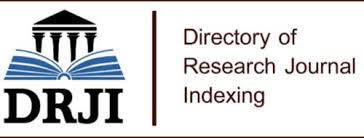Research Article
EVALUATION OF PATTERN OF MALARIA TREATMENT IN A HEALTH FACILITY IN BAYELSA STATE
- Dr. Owonaro A Peter
Corresponding author: Dr. Owonaro A Peter
Volume: 1
Issue: 1
Article Information
Article Type : Research Article
Citation : Peter A. Owonaro, Sounyo Adebukola, Chima Ifeanyi E, Daughter EA Owonaro, Seiyefa F. Brisibe. Evaluation Of Pattern of Malaria Treatment in A Health Facility in Bayelsa State. Journal of Medicine Care and Health Review 1(1). https://doi.org/10.61615/JMCHR/2024/MAY027140823
Copyright: © 2024 Peter A. Owonaro. This is an open-access article distributed under the terms of the Creative Commons Attribution License, which permits unrestricted use, distribution, and reproduction in any medium, provided the original author and source are credited.
DOI: https://doi.org/10.61615/JMCHR/2024/MAY027140823
Publication History
Received Date
02 Aug ,2024
Accepted Date
16 Aug ,2024
Published Date
23 Aug ,2024
Abstract
Malaria remains a major public health problem, particularly in sub-Saharan Africa. The disease carries a high burden in Nigerian society, thus making its treatment very important. The disease also presents with several co-morbidities and complications, thus requiring more drugs for treatment. This study examined the patterns of malaria treatment at General Hospital Amassoma (GHA) in Bayelsa State, Nigeria. A retrospective review of 225 patients' case notes diagnosed with malaria from January 2021 to January 2024 was conducted. The most common co-morbidities with malaria were enteric fever (24%), septicemia (8%), anxiety disorder (8%), anemia (5.33%), helminthiasis (5.33%), and arthritis (5.33%). The most frequently prescribed antimalarial drugs were injection artemether (64%), artemisinin-based combination therapy (ACT) (60%), followed by paracetamol (81.33%), amoxicillin (34.67%), and vitamin B complex (18.67%). Treatment patterns varied based on complicated vs uncomplicated malaria as well as specific co-morbidities. For uncomplicated malaria, common regimens included ACT, injection artemether, amoxicillin, and vitamin B complex. Severe malaria was often treated with parenteral artesunate followed by oral ACT, along with adjunctive medications. Antimalarial treatment adhered to WHO guidelines, though regimens were tailored to individual patient presentations and co-morbidities. These findings provide insights into real-world antimalarial prescribing practices in this endemic region of Nigeria.
►EVALUATION OF PATTERN OF MALARIA TREATMENT IN A HEALTH FACILITY IN BAYELSA STATE
Peter A. Owonaro1*, Sounyo Adebukola2, Chima Ifeanyi E3, Daughter EA Owonaro4, Seiyefa F. Brisibe5
123Niger Delta University, Wilberforce Island Bayelsa State, Faculty of Pharmacy, Department of Clinical Pharmacy and Pharmacy Practice.
45Niger Delta University, Wilberforce Island Bayelsa State, Faculty of Clinical Sciences, Department of Family Medicine.
Introduction
Malaria infection remains a public health problem in Africa resulting in morbidity and mortality, especially in Africa. In 2008, there were an estimated 243 million cases of malaria globally, with the majority (85%) in Africa. Of the 863,000 deaths worldwide reported, 89% were in Africa. [2,4,7,8,9,15,20] In Uganda, 10 million cases of malaria were reported with 43,000 deaths, of which 91% are children below 5 years of age [5,9,11,13,16,17,19,21,22,23,27]. Statistics reveal that malaria infection represents 20% to 50% of all consultations in health centers in Africa [1,3,6,24,38,46,59]. Reduction of mortality from malaria depends on an accurate early diagnosis and prompt effective drug treatment. The use of combination antimalarial therapy including Artemisinins remains the mainstay of treatment of the malaria parasite. However, the major concern with using Artemisinin-based Combination Therapy (ACT) is poor adherence to the treatment schedule. This study aims to investigate the patterns of malaria treatment at General Hospital Amassoma (GHA) in Bayelsa State, Nigeria
Method
Survey Instrument
Patients (participants) case notes for collection of demographic data, prescribed drug with doses, and any other information that could not be provided by the patient that is required in the study and is contained in the case note.
Study Design
It is a retrospective, non-experimental descriptive study. It involves using patient case notes to collect data such as the number of drugs prescribed for treatment, number of days of treatment, and drugs prescribed.
Setting of Study
Amassoma is a town in Southern Ijaw Local Government Area of Bayelsa State, Nigeria, where Niger Delta University is located. It is about 42 kilometers away from the state capital Yenegoa, Bayelsa State. As a result of the presence of the University, the population of the town is continuously growing.
The General Hospital Amassoma is located close to the College of Health Sciences with a total number of 65 staff.
Inclusive Criteria
- Adults of either gender
- Children of any age
Exclusive Criteria
- Patients having insufficient data record
- Allergic patients
- Pregnant patients
Method of Data Collection
225 patients' medical case notes were collected from GHA by systemic random sampling method of cases diagnosed with malaria in the facility from (January 2021 – January 2024) Data collected include the name of the facility, Patient ID code, Diagnosis (Malaria or Malaria with diseases), Age, Sex, Drug Prescribed /dosage regimen
Ethical Consideration
Consent of hospital management was sought through a letter to the hospital management board for approval in General Hospital Amassoma to access patients' records and case notes of which approval was granted. Confidentiality of patients was granted.
Results
Distribution of Respondents by Age
The study revealed the participation of two hundred and twenty-five (225) respondents within the main ages of 21.25+/-19.58 years. The study also revealed that the age ranges of the participants were between a year and 80 years in the study environment. This is as is shown in Figure 4.1 below.
Figure 4.1: Showing Distribution of respondents by age among patients attending General Hospital Amassoma, Bayelsa State

Mean age=21.2533, SD=19.57820, Min.= 1, Max.= 80
Distribution of Respondents by Gender and Patient Status
The study also revealed the participation of 45.33% males and 54.67% females of which 12% were in-patients and 88% were out-patients. This is shown in figure 4.2 below.
Figure 4.2: Showing percentage by gender and by patient status attending General Hospital, Amassoma Bayelsa state.

Common diseases in antimalarials prescriptions among patients attending General Hospital, Amassoma
The most common diseases found among the prescriptions containing antimalarials prescriptions were revealed to include enteric fever (24%), septicaemia (8%), anxiety disorder (8%), anaemia (5.33%), helminthiasis (5.33%), and arthritis (5.33%)
Table 4.1 Common diseases in antimalarials prescriptions among patients attending General Hospital, Amassoma
|
YES |
% |
NO |
% |
|
|
Malaria |
205 |
91.11 |
20 |
8.89 |
|
Enteric fever |
54 |
24.00 |
171 |
76.00 |
|
Severe malaria |
24 |
10.67 |
201 |
89.33 |
|
Septicemia |
18 |
8.00 |
207 |
92.00 |
|
Anxiety disorder |
18 |
8.00 |
207 |
92.00 |
|
Anemia |
12 |
5.33 |
213 |
94.67 |
|
Helminthiasis |
12 |
5.33 |
213 |
94.67 |
|
Arthritis |
12 |
5.33 |
213 |
94.67 |
|
Early cyeris |
7 |
3.11 |
218 |
96.89 |
|
Diarrhea |
6 |
2.67 |
219 |
97.33 |
|
Hemoglobinopathy |
6 |
2.67 |
219 |
97.33 |
|
Genital warts |
6 |
2.67 |
219 |
97.33 |
|
Urinary tract infection |
6 |
2.67 |
219 |
97.33 |
|
Body pains |
6 |
2.67 |
219 |
97.33 |
|
High blood pressure |
6 |
2.67 |
219 |
97.33 |
|
Catharact |
6 |
2.67 |
219 |
97.33 |
|
Chronic PID |
6 |
2.67 |
219 |
97.33 |
|
Bronchopneumonia |
6 |
2.67 |
219 |
97.33 |
|
Dermatitis |
6 |
2.67 |
219 |
97.33 |
|
Rhinitis |
3 |
1.33 |
3 |
1.33 |
Types of Drugs prescribed in antimalarials prescriptions among patients attending General Hospital, Amassoma
In decreasing order of frequency, the types of drugs mostly prescribed for patients in antimalarial treatment at General Hospital, Amassoma are Paracetamol (81.33%), and injection. Artemether (64%), tab ACT (60%), Amoxicillin (34.67%), and vitamin B. Complex (18.67%). This is contained in Table 4.2 below.
Table 4.2 Types of Drugs prescribed in antimalarials prescriptions among patients attending General Hospital, Amassoma
|
Yes |
No |
|||
|
Paracetamol |
61 |
81.33 |
12 |
16.00 |
|
Inj. Artemether |
48 |
64.00 |
25 |
33.33 |
|
Act |
45 |
60.00 |
28 |
37.33 |
|
Amoxicillin |
26 |
34.67 |
47 |
62.67 |
|
B.complex |
14 |
18.67 |
59 |
78.67 |
|
Albendazole |
13 |
17.33 |
60 |
80.00 |
|
Cefuroxime |
12 |
16.00 |
61 |
81.33 |
|
Ceftriaxone |
11 |
14.67 |
62 |
82.67 |
|
Artesunate |
9 |
12.00 |
64 |
85.33 |
|
Ciprofloxacin |
9 |
12.00 |
64 |
85.33 |
|
Promethazine |
9 |
12.00 |
66 |
88.00 |
|
Ibuprofen 400mg |
6 |
8.00 |
67 |
89.33 |
|
Diclofenac |
6 |
8.00 |
67 |
89.33 |
|
Tepid sponze |
6 |
8.00 |
69 |
92.00 |
|
Chlorpheniramine |
4 |
5.33 |
69 |
92.00 |
|
Zinc |
4 |
5.33 |
71 |
94.67 |
|
Neurogesic ointment |
4 |
5.33 |
71 |
94.67 |
|
Amitriptyline |
4 |
5.33 |
71 |
94.67 |
|
Lexotan |
4 |
5.33 |
71 |
94.67 |
|
Augmentin |
3 |
4.00 |
72 |
96.00 |
|
Metronidazole |
2 |
2.67 |
71 |
94.67 |
|
Buscopan |
2 |
2.67 |
71 |
94.67 |
|
Doxycycline |
2 |
2.67 |
71 |
94.67 |
|
Ivermectin |
2 |
2.67 |
71 |
94.67 |
|
Cerebrex |
2 |
2.67 |
73 |
97.33 |
|
Norflex |
2 |
2.67 |
73 |
97.33 |
|
Antacid |
2 |
2.67 |
73 |
97.33 |
|
Omeprazole |
2 |
2.67 |
73 |
97.33 |
|
Lisinopril |
2 |
2.67 |
73 |
97.33 |
|
Amlodipine |
2 |
2.67 |
73 |
97.33 |
|
Folic acid |
2 |
2.67 |
73 |
97.33 |
|
Primostat-N |
1 |
1.33 |
72 |
96.00 |
|
Ivs dextrose saline 5% |
1 |
1.33 |
74 |
98.67 |
|
Arthocare |
1 |
1.33 |
74 |
98.67 |
|
Erythromycin |
1 |
1.33 |
74 |
98.67 |
|
Satrepsil |
1 |
1.33 |
74 |
98.67 |
|
Tripple action cream |
0 |
0.00 |
73 |
97.33 |
|
Chymoral |
0 |
0.00 |
73 |
97.33 |
|
Fesolate |
0 |
0.00 |
73 |
97.33 |
Pattern of Antimalarial Treatment in General Hospital, Amassoma, Bayelsa state
4.5.1 Treatment patterns for uncomplicated malaria only
The treatment pattern for uncomplicated malaria was reported in this study. For such prescriptions, the drugs of common use were reported to include Paracetamol (72.89%), injection artemether (59.56%), tab ACT (53.78%), tab Amoxicillin (34.67%), and Vitamin B, complex (19.11%). This is contained in table 4.3 below
Table 4.3 Treatment patterns for uncomplicated malaria only

Treatment Patterns for Complicated Malaria
Most common complications of malaria as were indicated in this study included enteric fever, septicemia, anxiety disorder, anemia, helminthiasis, arthritis, and early cyeris. Table 4.4 below shows the types of drugs used in treating in the case of occurrence of a particular complication with malaria. In the occurrence of malaria and enteric fever, the most common drugs prescribed were ACT (17.33%), injection arthemether (14.67%), vitamin B. Complex (8%), ciprofloxacin (6.67%), followed by amoxicillin (5.33%). Those with complication of septicemia were treated more with paracetamol (8%), ACT(8%), injection artemether (8%), and amoxicillin (5.33%). Those with complications of anxiety disorder were favoured with prescriptions containing paracetamol (8%), artemether (8%) and Cefuroxime (8%). Other complications as reported are also contained in table 4.4 below.
Table 4.4. Percentage treatment patterns for complicated malaria

4.5.3 Malaria with Other Complications
Other complications with malaria were also reported. Those with Malaria + enteric fever + rhinitis were treated with Complication occurring with malaria + early cyesis + helminthiasis were treated with paracetamol, vitamin B Complex, injection artemether, albendazole, cefuroxime, and promethazine. Paracetamol, vitamin B. Complex, inj. Artemether, albendazole, Cefuroxime and promethazine (0.44%). Those with Malaria + early cyeris + helminthiasis were treated with Paracetamol, vitamin B. Complex, in. Artemether, albendazole, Cefuroxime, and promethazine. Those with Malaria + enteric fever + hemoglobinopathy were treated with Paracetamol, ACT, artesunate, and promethazine. Other reported complications included those of Malaria + enteric fever + genital warts, Malaria + Anemia + dermatitis, Malaria + hemoglobinopathy + genital warts, and Malaria + arthritis + catharact. This is contained in table 4.5 below
Table 4.5 Percentage occurrence of Malaria with other complications
|
|
Paracetamol |
ACT |
B.Complex |
inj. artemether |
Artesunate |
albendazole |
Ceftriazone |
Cefuroxime |
Promethazine |
primostat-N |
cerebrex |
norflex |
neurogesic ointment |
|
Malaria + early cyeris + helminthiasis |
0.44 |
|
0.44 |
0.44 |
|
0.44 |
|
0.44 |
0.44 |
|
|
|
|
|
Malaria + enteric fever + rhinitis |
1.33 |
|
|
1.33 |
|
|
|
|
|
1.33 |
|
|
|
|
Malaria + enteric fever + haemoglobinopathy |
2.67 |
2.67 |
|
|
2.67 |
|
2.67 |
|
2.67 |
|
|
|
|
|
Malaria + enteric fever + genital warts |
2.67 |
2.67 |
|
|
2.67 |
|
|
|
2.67 |
|
|
|
|
|
Malaria + Anaemia + dermatitis |
2.67 |
2.67 |
|
|
|
|
|
|
|
|
|
|
|
|
Malaria + haemoglobinopathy + genital warts |
2.67 |
2.67 |
|
|
2.67 |
|
|
|
2.67 |
|
|
|
|
|
Malaria + arthritis + catharact |
2.67 |
2.67 |
|
|
|
|
|
|
|
|
2.67 |
2.67 |
2.67 |
4.5.4 Severe Malaria with Complications
The study reported that patients with severe malaria were treated with a combination of paracetamol, ACT, and Ibuprofen 400mg, injection. Artemether, Artesunate, Ciprofloxacin, Albendazole, Ceftriaxone, Promethazine, and infusion Dextrose saline 5%. Those patients having severe malaria and enteric fever were mostly treated with paracetamol and ACT, whereas those having severe malaria and anemia were treated with paracetamol, ACT, Ibuprofen 400mg, inj. Artemether, ciprofloxacin, and or Ceftriaxone. This is contained in Table 4.6.
Table 4.6 Percentage occurrence of severe malaria and complications
|
Paracetamol |
ACT |
Ibuprofen 400mg |
Inj. Artemether |
Artesunate |
Ciprofloxacin |
Albendazole |
Ceftriaxone |
Promethazine |
Ivs Dextrose Saline 5% |
|
|
Severe Malaria |
10.67 |
8.00 |
2.67 |
4.00 |
2.67 |
2.67 |
6.67 |
6.67 |
1.33 |
1.33 |
|
Severe Malaria + Enteric Fever |
1.33 |
1.33 |
||||||||
|
Severe Malaria + Anemia |
2.67 |
2.67 |
2.67 |
2.67 |
2.67 |
2.67 |
Discussion of Findings
The study involved 225 respondents with a mean age of 21.25+/-19.58 years, ranging from 1 to 80 years old. Among them, 45.33% were males and 54.67% were females, with 12% being in-patients and 88% out-patients. The most common diseases found in prescriptions containing antimalarials were enteric fever (24%), septicemia (8%), anxiety disorder (8%), anemia (5.33%), helminthiasis (5.33%), and arthritis (5.33%). The most frequently prescribed drugs for antimalarial treatment were Paracetamol (81.33%), and injection. Artemether (64%), tab ACT (60%), Amoxicillin (34.67%), and vitamin B. Complex (18.67%). Complications of malaria included enteric fever, septicemia, anxiety disorder, anemia, helminthiasis, arthritis, and early cyeris. Treatment for complications varied, with different drugs prescribed based on the specific complication. For instance, ACT (17.33%) and injection artemether (14.67%) were commonly prescribed for malaria and enteric fever; Paracetamol (8%), ACT (8%), and injection artemether (8%) were used for septicemia; and Paracetamol (8%), artemether (8%), and Cefuroxime (8%) were favored for anxiety disorder.
Combination treatments were also noted for certain complications. For example, malaria + enteric fever + rhinitis was treated with Paracetamol, vitamin B. Complex, injection artemether, albendazole, Cefuroxime, and promethazine. Patients with severe malaria received various combinations of drugs such as paracetamol, ACT, Ibuprofen 400mg, inj. Artemether, Artesunate, Ciprofloxacin, Albendazole, Ceftriaxone, Promethazine, and ivs Dextrose saline 5%.
Discussion
The result above indicates a higher incidence of malaria infection among the female population [54.67%] as compared to 45.33% of males. This seems to agree with the previous report, malaria transmission varies due to gender and age, the high incidence rate observed in females compared to males might be due to hormonal changes in females which usually lead to loss of their resistance/ This implies that hormonal changes may reduce a woman’s immunity or resistance to malaria infection, making women susceptible and leading to the higher incidence among females [12,13,14,20,28,29,31,32,55,57].
The result also shows that the patterns and mean parasite density show that the age group ≤5 years has the highest malaria infection. Similar findings have been reported in previous studies. The World Health Organization has emphasized the fact that children between the ages of 5 years and below are the most vulnerable group of people, particularly in Africa. This can be attributed to the gradual loss of maternal immunity, coupled with a low level of acquired immunity among children compared to adults. Thus, as age and exposure increase, malaria infection decreases except among the elderly and the immunocompromised. Thus, the focus should be on children between the ages of five years and below, even in urban centers. Prevention against mosquito bites should be intensified through the provision of mosquito nets to such households with children. [34,35,36,38,39,41,52,53,54,40]
For uncomplicated malaria treatment, common drugs included Paracetamol (72.89%), injection artemether (59.56%), tab ACT (53.78%), tab Amoxicillin (34.67%), and Vitamin B. Complex (19.11%) which seems to also conform with the WHO’s treatment guideline of uncomplicated malaria which says treat children and adults with uncomplicated P. falciparum malaria [except pregnant women] with any of the recommended artemisinin-based combination therapies for the duration of 3 days [44,45,46,47,37].
Patients with severe malaria received various combinations of drugs such as paracetamol, ACT, Ibuprofen 400mg, inj. Artemether, Artesunate, Ciprofloxacin, Albendazole, Ceftriaxone, Promethazine, and ivs Dextrose saline 5%. This also seems to conform with the WHO’s treatment guideline for severe malaria which says to treat adults and children with severe malaria [including an infected, pregnant woman in all trimesters and lactating woman] with intravenous and intramuscular artesunate for at least 24hrs until they can tolerate oral medication, once a patient has received at least 24 hrs of parental therapy and can tolerate oral treatment, complete treatment with 3 days of ACT [31,55,56,57].
The study also highlighted the treatment patterns for complicated malaria cases, where different drugs were prescribed based on the specific complications or co-morbidities present. For instance, ACT (17.33%) and injection artemether (14.67%) were commonly prescribed for malaria with enteric fever, while Paracetamol (8%), ACT (8%), and injection artemether (8%) were used for septicemia cases. Combination therapies were also noted for certain complications, such as malaria with enteric fever and rhinitis, treated with Paracetamol, vitamin B. Complex, injection artemether, albendazole, Cefuroxime, and promethazine.
Conclusion
In conclusion, the findings of this study underscore the gender disparity in malaria incidence, with a higher prevalence observed among females, potentially attributed to hormonal changes impacting their immunity. Moreover, the treatment patterns revealed adherence to WHO guidelines for both uncomplicated and severe malaria cases, emphasizing the importance of evidence-based approaches in combating this infectious disease. This insight contributes to our understanding of malaria epidemiology and informs healthcare strategies aimed at reducing its burden, particularly among vulnerable populations.
Overall, the findings underscore the importance of tailoring antimalarial treatment to individual patient presentations, considering co-morbidities, and aligning with evidence-based guidelines to ensure optimal management of this life-threatening disease in malaria-endemic regions.
Recommendations
Healthcare providers should prioritize patient education and counseling to enhance malaria treatment guidelines/ knowledge and medication adherence.
Contribution to Literature
This study's findings have contributed to an existing body of knowledge on ways of improving patient outcomes in malaria treatment, as well as improving healthcare system efficiency.
Acknowledgment
The researchers appreciate the statistician, respondents, and co-researchers for the time.
Conflict of Interest
The researchers declare that there was no conflict of interest.
- Adeoye, G.O, Nga, I.C. (2007). Comparison of Quantitative Buffy Coat technique (QBC) with Giemsa-stained Thick Film (GTF) for diagnosis of malaria. Parasitology International. 56(4): 308-312.
- Barman, D, Mirdha, B.R, Samantray, J.C, Kironde, F, Kabra, S.K, Guleria, R. (2003). Evaluation of quantitative buffy coat (QBC) assay and polymerase chain reaction (PCR) for diagnosis of malaria. Journal Community Dis. 35(3): 170-181.
- Bartoloni, A, Zammarchi, L. (2012). "Clinical aspects of uncomplicated and severe malaria". Mediterranean Journal of Hematology and Infectious Diseases. 4(1): 2012026.
- Baruch, D.I, Gormely, J.A, Ma, C. (1996). Plasmodium falciparum erythrocyte membrane protein 1 is a parasitized erythrocyte receptor for adherence to CD36, thrombospondin, and intercellular adhesion molecule 1. ProcNatlAcadSci USA. 93(8): 3497-3502.
- Baruch, D.I, Ma, X.C, Singh, H.B. (1997). Identification of a region of PfEMP1 that mediates adherence of Plasmodium falciparum infected erythrocytes toCD36: conserved function with variant sequence. 90(9): 3766-3775.
- Baruch, D.I, Pasloske, B.L, Singh, H.B. (1995). Cloning the P. falciparum gene encoding PfEMP1, a malarial variant antigen and adherence receptor on the surface of parasitized human erythrocytes [see comments]. Cell. 82(1): 77-87.
- Bawah, A.A, Binka, F.N. (2005). 'How many years of life could be saved if malaria were eliminated from a hyperendemic are of Northern Ghana, population Council Working. 203.
- Beare, N.A, Lewallen, S, Taylor, T.E, Molyneux, M. E. (2011). "Redefining cerebral malaria by including malaria retinopathy". Future Microbiology 6(3): 349-355.
- Bell, D, Wongsrichanalai, C, Barnwell, J.W. (2006). Ensuring quality and access for malaria diagnosis: how can it be achieved? Nat Rev Microbiology. 4(9): 7-20.
- Bell, D.R, Jorgensen, P, Christophel, E.M, Palmer, K.L. (2005). Malaria risk: estimation of the malaria burden. Nature. 437(7056): 3-4.
- Bledsoe, G.H. (2006). "Malaria primer for clinicians in the United States". Southern Medical Journal. 98 (12): 1197-1204.
- Bull, P.C, Lowe, B.S, Kortok, M. (1998). Parasite antigens on the infected red cell surface are targets for naturally acquired immunity to malaria. National Medical. 4(3): 358-360.
- Bustos, D.G, Olveda, R.M, Negishi, M, Kurimura, T. (1999). Evaluation of a new rapid diagnostic test "Determine Malaria PF" against standard blood film, ICTMalaria P.F and ParaSight F. Jpn J Trop Med Hyg. 417-442.
- Charles, C. E, Brian O.O. Obinna, I. E, Mathew, J.O, Charles, O.E. (2014). Drug use pattern for uncomplicated malaria in medicine retail outlets in Enugu urban, southeast Nigeria: implications for malaria treatment policy.
- Chen, Q, Fernandez, V, Sundstrom, A. (1998). Developmental selection of var gene expression in Plasmodium falciparum. Nature. 394(6691): 392-395.
- Chilton, D, Malik, A.N, Armstrong, M, Kettelhut, M, Parker-Williams, Chiodini, P.L. (2006). Use of rapid diagnostic tests for diagnosis of malaria in the UK. J Clin Pathol. 59(8): 862-866.
- Clark, I.A, Cowden, W.B. (1999). Why is the pathology of falciparum worse than that of vivax malaria? Parasitology. 15(11): 458-461.
- Cowan, S. (2007). Inequality in household decision making for early treatment of malaria in young children: a case study in Northern Ghana. Geographical Journal Health Science. 4:1.
- DeLeire, T, Manning, W. (2004). "Labour market costs of illness: prevalence matters", Health Economics. 13: 239-250.
- Erdman, L.K, Kain, K.C. (2008). Molecular diagnostic and surveillance tools for global malaria control. Travel Med Infect Dis. 6(1-2): 82-99.
- Clendennen, T.E, Long, G.W, Baird, K.J, Giemsa, Q.B.C. (1995). stained thick blood films: diagnostic performance of laboratory technologists. Trans R SocTropMedHyg. 89(2): 183-184.
- Federal Ministry of Health "National Malaria Control Programmes 5-year strategic plan 2006-2010; A Road map for impact on malaria in Nigeria "Abuja, Nigeria. 1-36.
- Francesco Castelli, Lina RacheleTomasoni, and Alberto Matteelli. (2012). MEDITERRANEAN JOURNAL OF HEMATOLOGY AND INFECTIOUS DISEASES.
- Fried, M, Duffy, P.E. (1998). Maternal malaria and parasite adhesion. J MolMed. 76(3-4): 162-171.
- Funk, M, Schlagenhauf, P, Tschopp, A, Steffen, R, MalaQuick. (1999). ParaSight F as a diagnostic aid in travellers' malaria. Trans R Soc Trop Med Hyg. 93(3): 268-272.
- Greenwood, B, Mutabingwa, T. (2002). "Malaria in 2002". Nature. 415 (6872): 670-672.
- Hartman, T.K, Rogerson, S.J, Fischer, P. R. (2010). "The impact of maternal malaria onnewborns". Annals of Tropical Paediatrics. 30(4): 271-282.
- Howard, R.J, Barnwell, J.W, Kao, V. (1983). Antigenic variation of Plasmodium knowlesi malaria: identification of the variant antigen on infected erythrocytes. Proc Natl AcadSci USA. 80(13): 4129-4133.
- Kajfasz, P. (2009). "Malaria prevention". International Maritime Health. 60 (1-2): 67-70.
- Kim, S.H, Nam, M.H, Roh, K.H, Park, H.C, Nam, D.H, Park, G.H, Han, E.T, Klein, T.A, Lim, C.S. (2008). Evaluation of a rapid diagnostic test specific for Plasmodium vivax. Trop Med Int Health. 13(12): 1495-1500.
- Leech, J.H, Barnwell, J.W, Miller, L.H, Howard, R.J. (1984). Identification of a strain-specific malarial antigen exposed on the surface of Plasmodium falciparum-infected erythrocytes. J Exp Med. 159(6): 1567-1575.
- Looareesuwan, S, Wilairatana P. (1999). Clinical Tropical Medicine. 1st edition Bangkok, Thailand: Medical Media. 5-10.
- Ouédrago, L.T, Somé, I.T, Diarra, M, Guissou, J.P. (2008). Self-medication in the treatment of acute malaria: study based on users of private health drug stores in Ouagadougou, Burkina Faso. Bull Soc Path Exot. 101(2): 124-127.
- McCutchan, T.F, Piper, R.C, Makler, M.T. (2008). Use of malaria rapid diagnostic test to identify Plasmodium knowlesi infection. Emerg Infect Dis. 14(11): 1750-1752.
- Moody, A. (2002). Rapid diagnostic tests for malaria parasites. Clinical Microbiology Rev. 15(1): 66-78.
- Mwangi, T.W, Mohammed, M, Dayo, H, Snow, R.W, Marsh, K. (2005). Clinical algorithms for malaria diagnosis lack utility among people of different age groups. Trop Med Int Health. 10(6): 530-536.
- Nadjm, B, Behrens, R.H. (2012). "Malaria: An update for physicians". Infectious Disease Clinics of North America. 26(2): 243-259.
- Newbold, C, Warn, P, Black, G. (1997). Receptor specific adhesion and clinical disease in Plasmodium falciparum. American Journal of Tropical Medical Hygiene. 57(4): 389-398.
- Newbold CI, Craig AG, Kyes S. (1997). P/EMP1, polymorphism and pathogenesis. Annual Tropical Medical Parasitology. 91(5): 551-557.
- Noedl, H, Yingyuen, K, Laoboonchai, A, Fukuda, M, Sirichaisinthop, J, Miller, R.S. (2006). Sensitivity and specificity of an antigen detection ELISA for malaria diagnosis. America Journal Tropical Medical Hygiene.75(6): 1205-1208.
- Chola, L.B, Vounatsou, P, Smith, T, Mabaso, M.L, Newton, C.R. (2006). The reliability of diagnostic techniques in diagnosis and management of malaria in absence of a gold standard. Lancet Infect Di. 6(9): 582-588.
- Oluwaseun, B. (2021). A cross-sectional study of the prevalence, density, and risk factors associated with malaria transmission in urban communities of Ibadan, Southwestern Nigeria. 7(1): 05975.
- OkokonItaIta, Kenneth, O, Anthony A, Ubong A. U. (2019). The Pattern of Severe Malaria in Plateau State of Nigeria: A Five-Year Review of Severe Malaria Case-Based Surveillance Data from 2013 to 2017. 51(1): 52-57.
- Our, C, Puromo, Sulamiardia, M.A, Tang, D, Kain, K.C. (2002). Impact of microscopy error on estimates of protective efficacy in malaria prevention trials. J Infect Dis.186(4): 540-546.
- Park 75, Kim, J.I, Kang, C, Lee, B.H, Jeon, B.R, Lee, S.M, Chang, C.L, Lee, B.Y, Son, H.C, Kim, H.H. (2006). Diagnostic usefulness of SD malaria antigen and antibody kits for differential diagnosis of vivax Malaria in patients with fever of unknown origin. Korean Journal Laboratory Medicine.26(4): 241-245.
- Payne D. (1988). Use and limitations of light microscopy for diagnosing malaria at the primary health care level. Bull World Health Organisation.66(5): 621-628.
- Pornsilapatip, J, Namsiripongpun, V, Wilde, H, Hanvanich, M, Chutivongse, S. (1990). Detection of Plasmodia in acridine orange-stained capillary tubes (the QBC system). Southeast Asian Journal Tropical Medical Public Health.21(4): 534-540.
- Pouvelle, B, Buffet, P.A, Lepolard, C. (2000). Cytoadhesion of plasmodium falciparum ringstage-infected erythrocytes. National Medicine.6(11): 1264-1268.
- Reeder, J.C, Cowman, A.F, Davern, K.M. (1999). The adhesion of Plasmodium falciparum-infected erythrocytes to chondroitin sulfate A is mediated by P. falciparum erythrocyte membrane protein 1. Proc Natl AcadSci USA.96(9): 5198-5202.
- Owusu-Agyei S, Asante, K.P, Aduik, P. (2009). Epidemiology of malaria in the forest-savannah traditional zone of Ghana, Malaria Journal Article. 220
- Kiriviki, S.N, Thomas, N.W. (2022). Human genetics and malaria resistance.139(6): 801-811.
- Ovus-Agy, K.P, Asanto. M. Adjuik. (2009). Epidemiology of Malaria in the forest-savannah transitional zone of Ghana, Malaria Journal Article. 220.
- Wahlgren, M, Barragan, A, Chen Q. (1998). Rosetting of malaria-infected erythrocytes: ligands, host receptors, and the involvement of serum proteins. In: Sherman IW, ed. Malaria: parasite biology, pathogenesis, and protection. Washington, DC: ASM Press. 387-398.
- Waller, K.L, Cooke, B.M, Nunomura, W. (1999). Mapping the binding domains involved in the interaction between the Plasmodium falciparum knob-associated histidine-rich protein (KAHRP) and the cytoadherence ligand P. falciparum erythrocyte membrane protein 1 (PfEMP1). Journal Biology Chemistry.274(34): 23808-23813.
- Warhurst, D.C, Williams, J.E. (1996). Laboratory diagnosis of malaria. Journal of Clinical Pathology.49(7): 533-538.
- World Health Organization. (2006). Guidelines for the treatment of malaria. Ist edition. Geneva, Switzerland. 133-143.
- World Health Organization. WHO. (1996). information consultation on recent advances in diagnostic techniques and vaccines for malaria: a rapid dipstick antigen capture assay for the diagnosis of falciparum malaria. Bull World Health Organisation.74(1): 47-54.
- World Health Organization. (2001). Anti-malaria drug combination therapy.Geneva, Switzerland: Report of a WHO Technical Consultation.35.
- World Health Organization. (2015). Guidelines for the treatment of malaria 3rd Edition page. 31-34.
- World Health Organization. (2015). Guidelines for the treatment of malaria 3rd Edition. 316.
Download Provisional PDF Here
PDF




p (1).png)




.png)




.png)
